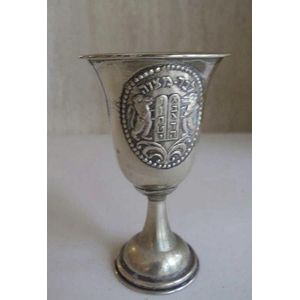Edwardian Sterling Silver Twin Handled Vase - Neo-Classical Design
Edwardian VII sterling silver twin handled vase, neo-classical design of elongated ovoid shape on loaded circular base, 27 cm height
You must be a subscriber, and be logged in to view price and dealer details.
Subscribe Now to view actual auction price for this item
When you subscribe, you have the option of setting the currency in which to display prices to $Au, $US, $NZ or Stg.
This item has been sold, and the description, image and price are for reference purposes only.
- Oviform /ovoid - The outline loosely resembling the shape of an egg.
- Loaded - In silverware the hollow part of the object, such as the stem of a candlestick or the handle of a knife, that has been filled (loaded) with pitch or sand to add additional weight for stability.
- Sterling Silver - Sterling silver is a mixture of 92.5% pure silver and 7.5% of another metal, usually copper. Fine silver is 99.9% pure silver, and is relatively soft and the addition of the very small amount of copper gives the metal enough strength and hardness to be worked into jewellery, decorative and household objects.
- Edwardian - The Edwardian period of English furniture and decorative arts design is named for Edward VII (1841 ? 1910) who was King of the United Kingdom and the British Dominions and Emperor of India for the brief period from 1901 until his death in 1910. It follows the Victorian period, in turn was followed by the Art Nouveau and Art Deco styles. In Australia, designs of this period are also known as being in the Federation style.
- Neo Classical - The period or style, known as "neo-classical", was based on Greek and Roman designs and motifs, and is usually associated with the influence of the four Adam brothers, but principally Robert Adam, the second oldest of the brothers, who were architects and designers, active in the latter half ot the 18th century (1760s to 1790s).
Born in Scotland in 1728, Robert Adam spent time in Italy studying and his designs are influenced by the finds made during the excavation of Pompei.
When he returned to England he became the Court Architect to George III (1738-1820).
In turn, designs by Adam then influenced Hepplewhite.
Neo-classical ornamentation is characterised by use of classical urns, palmettes, mythical creatures such as the sphinx and griffin, ram's heads, swags, scrolling foliage, and use of the Greek key pattern.
This item has been included into following indexes:
Visually similar items

Pair of sterling silver two handled vases, Birmingham 1909 by Spurrier & Co, height 30 cm
Sold by
in
for
You can display prices in $Au, $US, $NZ or Stg.

Lalique crystal scent bottle 14 cm high approx.
Sold by
in
for
You can display prices in $Au, $US, $NZ or Stg.

Royal Worcester specimen vase ovoid body painted with highland sheep signed H Davis 28.5 cm height
Sold by
in
for
You can display prices in $Au, $US, $NZ or Stg.

European silver kiddush cup stamped marks 800, measures 10.7 cm ht weighs 40 grams
Sold by
in
for
You can display prices in $Au, $US, $NZ or Stg.
